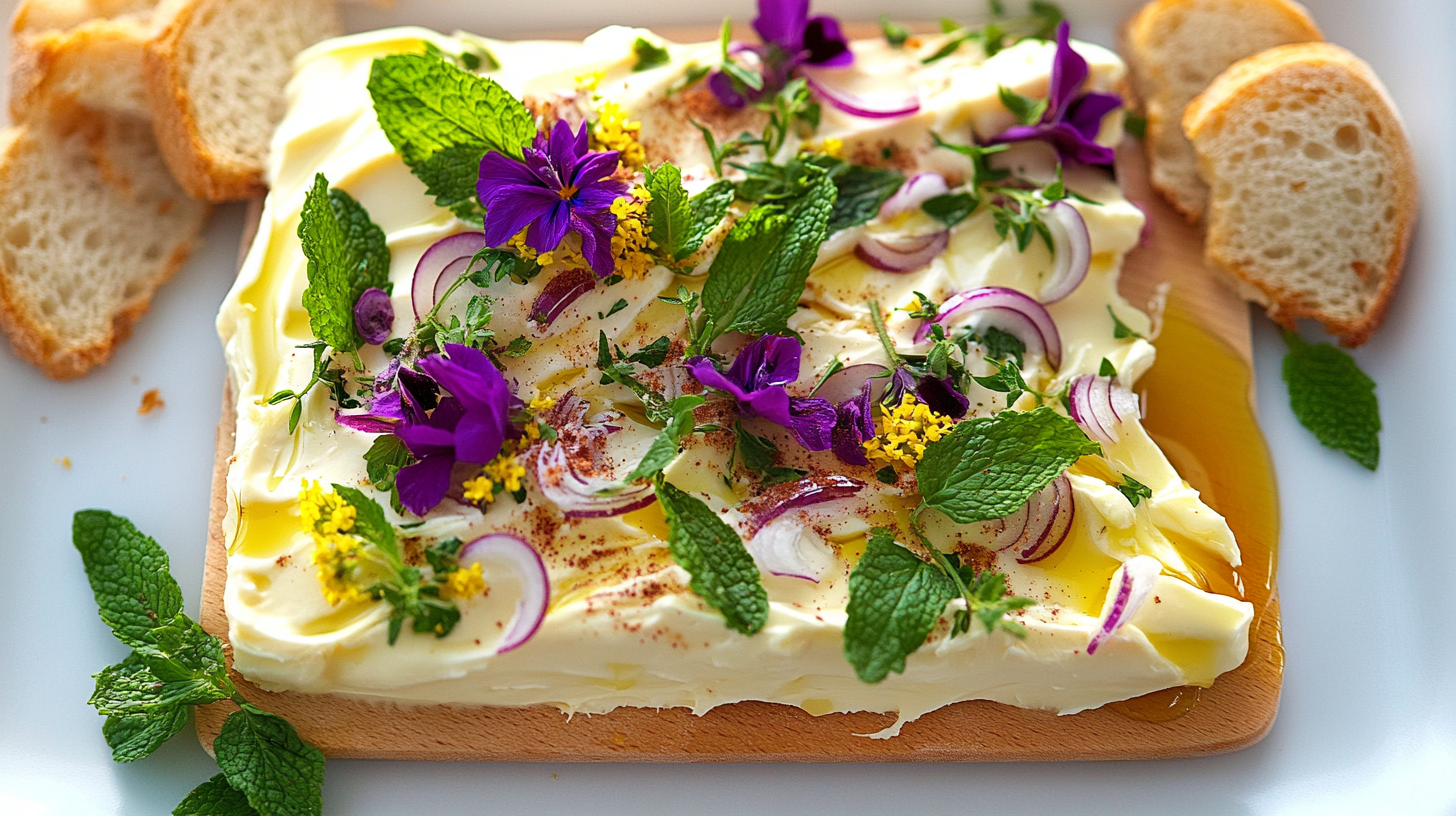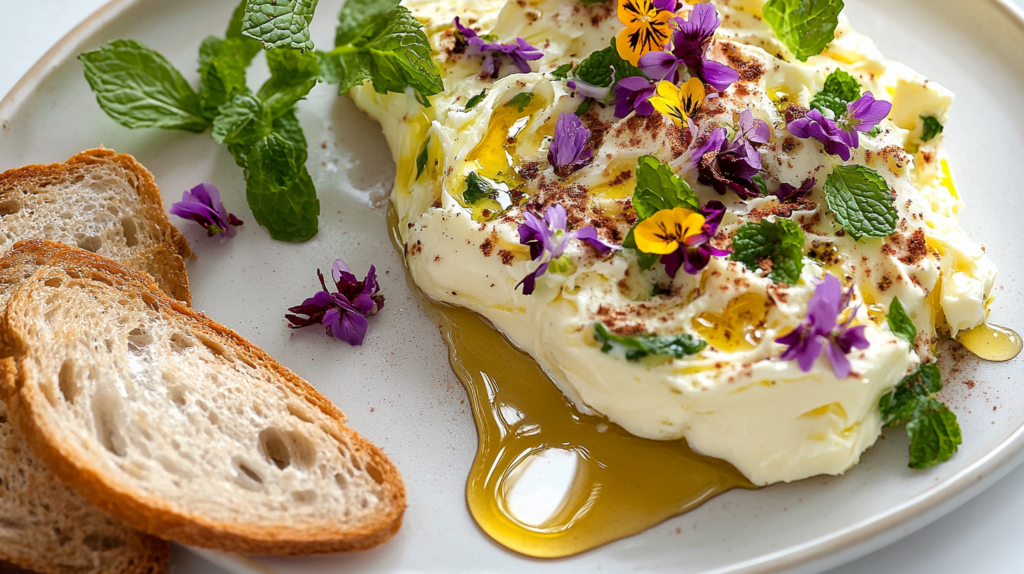
Butter Board Recipe
Table of Contents
Creamy, customizable, and completely Instagram-worthy, the Butter Board has revolutionized how we think about appetizers. Imagine a canvas of velvety, softened butter spread across a wooden board, then adorned with a tapestry of colorful toppings, fragrant herbs, and drizzles of honey or olive oil. This trendy dish first exploded on social media in 2022, and unlike many food fads, it’s proven it has staying power because of its endless versatility and undeniable wow-factor. What makes the Butter Board truly special is how it transforms something we often take for granted (butter!) into the star of the show, while requiring minimal effort but delivering maximum impact. In just 10 minutes, you can create an appetizer that will have guests reaching for their phones to snap photos before they dive in with pieces of crusty bread. While charcuterie boards (like my popular Mediterranean Mezze Platter recipe) require multiple expensive ingredients and careful arrangement, the Butter Board achieves the same impressive presentation with fewer components and significantly less preparation time. Ready to create a show-stopping starter that looks like it took hours but comes together in minutes? Let’s spread some joy with these five spectacular Butter Board variations!
What is Butter Board?
Ever wondered what happens when butter breaks free from its supporting role and becomes the headlining act? That’s exactly what a Butter Board is! This culinary trend takes softened butter, spreads it artistically across a wooden board (hence the name!), and transforms it into an edible masterpiece with toppings ranging from flaky salt to edible flowers. The concept was pioneered by chef Joshua McFadden but truly went viral when social media creators realized its jaw-dropping visual appeal. It’s like butter decided to dress up for a night on the town instead of hiding inside the bread! As they say, “the way to anyone’s heart is through their stomach,” and nothing captures hearts faster than this beautiful blend of simplicity and sophistication. Whether you’re hosting an elegant dinner party or just want to make Tuesday night special, creating your first Butter Board is like giving yourself a standing ovation in the kitchen. Ready to spread some happiness? Let’s get started!
Why You’ll Love This Butter Board:
This Butter Board recipe will revolutionize your entertaining game through its perfect blend of simplicity and sophistication. First and foremost, the visual impact is absolutely stunning. Unlike complicated appetizers that require precise cooking techniques, these Butter Boards transform basic ingredients into an artistic display that looks professionally crafted. The contrast of colorful toppings against the pale butter canvas creates an appetizer that’s not just delicious but genuinely beautiful, guaranteed to elicit oohs and aahs from your guests before they’ve taken a single bite.
Beyond aesthetics, the economic advantage is remarkable. While traditional charcuterie boards often require $30-50 worth of specialty meats and cheeses, a spectacular Butter Board costs a fraction of that price. The base of quality butter (even splurging on European varieties) remains affordable, while toppings utilize small amounts of ingredients you likely already have in your pantry or refrigerator. This cost efficiency extends to reducing food waste as well, as you can incorporate small amounts of herbs or vegetables that might otherwise go unused.
The flavor experience is what truly makes Butter Boards exceptional. The butter serves as both a spread and a flavor carrier, melting slightly at room temperature to create the perfect consistency for capturing the essence of your chosen toppings. From the bright zing of citrus zest to the earthy depth of roasted garlic, each bite offers a different combination of tastes and textures. Unlike my popular Whipped Feta Dip which offers one consistent flavor profile, Butter Boards provide a journey of taste discoveries as guests explore different sections and combinations. Ready to create your own edible masterpiece? Let’s explore five distinctive variations that will transform any gathering from ordinary to extraordinary!

How to Make Butter Board:
Quick Overview
Creating a stunning Butter Board is remarkably simple yet delivers incredible visual and flavor impact. The beauty of this appetizer lies in its perfect balance between sophisticated presentation and down-to-earth deliciousness. At its core, you’re spreading softened butter on a serving board and adorning it with complementary toppings, but the result is far greater than the sum of its parts. The entire process takes just 8-10 minutes from start to finish, making it perfect for last-minute entertaining or adding an unexpected special touch to casual gatherings. Best of all, the variations are endless, allowing you to customize based on your preferences, what’s in season, or the theme of your meal.
Key Ingredients for Butter Board:
Base Ingredients (used in all variations): • 2 sticks (1 cup) high-quality unsalted butter, softened at room temperature • 1 loaf crusty bread (sourdough, baguette, or ciabatta), sliced for serving • Wooden serving board or large plate
For Variation 1: Sweet & Spicy Honey Board • 3 tablespoons high-quality honey • 1 teaspoon red pepper flakes • 1 tablespoon fresh thyme leaves • 1 teaspoon flaky sea salt • Zest of 1 lemon
For Variation 2: Mediterranean Herb Board • 2 tablespoons extra virgin olive oil • 1/4 cup mixed fresh herbs (rosemary, oregano, basil) • 2 cloves roasted garlic, smashed • 1 tablespoon lemon zest • 1/2 teaspoon flaky sea salt • 10 cherry tomatoes, halved
For Variation 3: Everything Bagel Board • 2 tablespoons everything bagel seasoning • 4 green onions, thinly sliced • 2 ounces cream cheese, softened • 1 tablespoon fresh dill, chopped • 1/2 lemon, juice only
For Variation 4: Sweet Fig & Walnut Board • 4 fresh or dried figs, thinly sliced • 1/4 cup toasted walnuts, roughly chopped • 2 tablespoons maple syrup or honey • 1 teaspoon cinnamon • Pinch of nutmeg • 1 teaspoon orange zest
For Variation 5: Savory Umami Board • 1 tablespoon miso paste • 2 teaspoons soy sauce • 1 teaspoon grated ginger • 1 tablespoon toasted sesame seeds • 2 teaspoons furikake seasoning • 1 green onion, thinly sliced • 1 teaspoon rice vinegar
Instructions:
Basic Butter Board Preparation (for all variations):
- Allow butter to soften at room temperature for about 30 minutes until spreadable but not melted.
- Select an appropriate serving board – wood offers the best presentation, but a large plate works too.
- Using the back of a spoon or an offset spatula, spread the softened butter in an artistic, swirled pattern across the board, creating peaks and valleys to capture toppings.
- Leave about a 1-inch border around the edge for easy handling.
Variation 1: Sweet & Spicy Honey Board
- After spreading butter on the board, drizzle with honey in a zigzag pattern.
- Sprinkle red pepper flakes evenly across the surface.
- Distribute fresh thyme leaves throughout.
- Add lemon zest across the board.
- Finish with a generous sprinkle of flaky sea salt.
- Serve immediately with sliced crusty bread.
Variation 2: Mediterranean Herb Board
- Spread butter across the board in a rustic pattern.
- Drizzle with high-quality olive oil.
- Distribute fresh herbs evenly across the surface.
- Place roasted garlic pieces throughout the board, lightly pressing into the butter.
- Arrange halved cherry tomatoes in an appealing pattern.
- Sprinkle with lemon zest and flaky sea salt.
- Serve with warm bread slices.
Variation 3: Everything Bagel Board
- Spread butter on the board, leaving some of the cream cheese visible in dollops or swirls.
- Sprinkle everything bagel seasoning generously across the surface.
- Scatter sliced green onions throughout.
- Distribute fresh dill across the board.
- Squeeze lemon juice lightly over the entire surface.
- Serve with bagel chips or crusty bread.
Variation 4: Sweet Fig & Walnut Board
- Spread butter across the board in sweeping motions.
- Arrange fig slices in a visually pleasing pattern.
- Scatter chopped walnuts evenly throughout.
- Drizzle with maple syrup or honey.
- Dust with cinnamon and a pinch of nutmeg.
- Finish with orange zest sprinkled across the top.
- Serve with sliced bread or sweet crackers.
Variation 5: Savory Umami Board
- In a small bowl, mix miso paste and soy sauce until smooth.
- Spread butter across the board.
- Drizzle or dollop the miso mixture across the butter.
- Sprinkle with grated ginger.
- Scatter sesame seeds and furikake throughout.
- Add sliced green onions.
- Finish with a few drops of rice vinegar.
- Serve with sliced bread or rice crackers.
What to Serve Butter Board With:
A Butter Board isn’t just an appetizer; it’s an interactive experience that pairs beautifully with thoughtfully selected accompaniments. The foundation of any Butter Board presentation is the bread selection. Offer a variety of options like thinly sliced baguette, chunks of sourdough, seeded crackers, and flatbreads to provide textural contrast and accommodate different preferences. For the best experience, slightly toast or warm the bread to create that magical contrast between the cool, creamy butter and warm, crisp bread.
For a complete appetizer spread, consider balancing your Butter Board with complementary small bites. Fresh crudités like cucumber slices, radishes, and bell pepper strips offer a refreshing crunch that cuts through the richness of the butter. A small bowl of mixed olives provides a briny counterpoint that enhances the savory variations.
Beverage pairings elevate the entire experience to another level. For wine enthusiasts, a crisp Sauvignon Blanc or sparkling Prosecco beautifully complements the herb-forward variations, while a medium-bodied Chardonnay stands up well to the richer, sweeter boards. If serving cocktails, consider the refreshing contrast of a cucumber gin spritz or the complementary warmth of an old fashioned with the sweet and spicy honey variation. For non-alcoholic options, sparkling water infused with herbs or a tart lemonade provides the perfect palate-cleansing accompaniment.
When incorporating a Butter Board into a larger meal, consider it as the opening act that sets the stage for your main course. It pairs particularly well before pasta dishes, roasted meats, or hearty soups, creating a cohesive flavor journey throughout your meal.
Top Tips for Perfecting Butter Board:
Creating a truly memorable Butter Board requires attention to a few key details that transform it from good to extraordinary. First and foremost, temperature management is crucial. The butter should be softened to the perfect consistency: too cold and it will be difficult to spread artistically; too warm and it will lose its structure. For ideal results, leave butter at room temperature for exactly 30 minutes before spreading. If you’re in a hurry, cut the butter into small cubes to speed up the softening process, but never microwave it, as this creates uneven softening.
Quality ingredients make all the difference in a dish with so few components. Splurge on European-style butter with higher fat content for a richer, creamier result. Vermont Creamery and Kerrygold are excellent options that provide a noticeable upgrade in flavor and texture. Similarly, use fresh herbs rather than dried whenever possible, and invest in a good quality flaky sea salt like Maldon or fleur de sel for finishing.
For visual impact, consider the principles of color and contrast when arranging your toppings. Create intentional patterns rather than random scattering, and group complementary colors together for maximum visual appeal. Using elements of different heights – like honey drizzles, vertical herb sprigs, or stacked ingredients – creates dimension that makes your board more interesting from every angle.
Common mistakes to avoid include overcrowding the board (which makes it difficult for guests to navigate) and using too many competing flavors. Instead, choose a cohesive flavor profile with complementary elements. For serving success, provide a dedicated knife or spreader for the board and smaller individual knives for guests to use with their bread. This prevents the awkward scenario of guests trying to spread directly from the board to their bread.
Finally, timing matters. For maximum flavor and visual appeal, prepare your Butter Board no more than 30 minutes before serving. This allows the flavors to meld slightly while maintaining the board’s fresh appearance and preventing the butter from becoming too soft or the herbs from wilting.
Storing and Reheating Tips:
While Butter Boards are ideally prepared fresh for immediate consumption, real-world entertaining sometimes requires advance preparation or dealing with leftovers. For short-term storage of a prepared board (up to 2 hours before serving), cover it loosely with plastic wrap and refrigerate. About 20 minutes before guests arrive, remove it from the refrigerator to allow the butter to soften slightly for the ideal spreading consistency. This brief advance preparation can actually improve flavor development as the toppings have time to infuse the butter.
For longer-term planning, prepare and refrigerate the components separately. Soften and spread the butter on the board up to 12 hours ahead, cover with plastic wrap, and refrigerate. Prepare your toppings and store them separately in airtight containers in the refrigerator. About 30 minutes before serving, remove the butter board from the refrigerator to soften slightly, then add the toppings just before guests arrive for the freshest presentation.
If you find yourself with leftover Butter Board at the end of your gathering (though this is rare!), you have several creative options for repurposing. Carefully scrape the butter and toppings into an airtight container and refrigerate for up to 3 days. This compound butter can be used to enhance other dishes: melt it over grilled steak or fish, toss it with hot pasta, or use it to finish roasted vegetables. The sweet variations make excellent toppings for waffles or pancakes the next morning.
For the accompanying bread, store any unused slices in a paper bag at room temperature if using within 24 hours. For longer storage, freeze the bread slices in a zip-top freezer bag for up to one month. Refresh refrigerated bread by warming in a 350°F oven for 5 minutes or frozen bread for 7-8 minutes until heated through.
Remember that butter absorbs other flavors readily, so always use airtight storage containers to prevent your carefully crafted Butter Board flavors from picking up unwanted refrigerator odors. With these storage strategies, you can minimize waste and maximize enjoyment of your culinary creation.
FAQs About Butter Board
What’s the best type of butter to use for a Butter Board?
For the best Butter Board experience, choose high-quality, unsalted European-style butter with a higher fat content (at least 82%). Brands like Kerrygold, Plugrá, or Vermont Creamery create a richer, creamier foundation that spreads beautifully and provides superior flavor. Unsalted butter is preferred as it gives you complete control over the salt level when adding toppings. If you only have salted butter available, simply reduce or eliminate additional salt in your toppings. For specialty variations, consider cultured butter for a tangy depth of flavor that pairs particularly well with honey or fruit toppings.
How far in advance can I prepare a Butter Board?
While Butter Boards are best when freshly prepared, you can prepare most components ahead of time. For optimal results, spread the butter on your board up to 4 hours before serving and keep refrigerated, covered with plastic wrap. Prepare toppings separately and store them in the refrigerator. About 30 minutes before serving, remove the butter board from the refrigerator to slightly soften, then add the toppings just before guests arrive. This approach maintains the fresh appearance of herbs and prevents the butter from becoming too soft while still allowing flavor infusion to begin.
What serving board works best for a Butter Board?
The ideal serving surface for a Butter Board is a wooden board or slab with a smooth, food-safe finish. Wood not only provides rustic aesthetic appeal but also helps maintain the butter’s temperature better than glass or ceramic. Look for boards made from maple, walnut, or olive wood in a size appropriate for your gathering (8-12 inches for 4-6 people, 12-16 inches for larger groups). If you don’t have a wooden board, marble pastry slabs, slate serving pieces, or even large ceramic platters can work beautifully as alternatives. Whatever material you choose, select a board with a slight lip or edge to prevent any melting butter or toppings from dripping onto the table.
Can I make a dairy-free or vegan Butter Board?
Absolutely! Plant-based Butter Boards can be just as delicious and visually stunning as traditional versions. Select a high-quality vegan butter that has good spreadable texture and neutral flavor – brands like Miyoko’s Creamery or Earth Balance work particularly well. Allow the plant-based butter to soften at room temperature until it reaches a consistency similar to traditional butter. From there, follow the same topping and presentation guidelines as with dairy butter. For vegan variations, focus on Mediterranean or umami flavors to complement the plant-based butter’s profile. Serve with dairy-free crackers or bread to keep the entire appetizer vegan-friendly.
Why is my Butter Board getting too melty?
An overly soft Butter Board typically results from temperature issues. Butter should be softened enough to spread easily but still maintain its structure. If your butter becomes too melty, it was likely left at room temperature too long or placed in a warm environment. For optimal texture, soften butter at room temperature (around 70°F) for no more than 30-40 minutes. During summer months or in warm kitchens, reduce this time to 20 minutes. After spreading on your board, if you’re not serving immediately, refrigerate the board for 10 minutes to reset the butter’s structure before adding toppings. When serving, place the board away from heat sources like sunny windows, candles, or hot serving dishes to maintain its appealing texture throughout your gathering.
How do I create an aesthetically pleasing Butter Board?
Creating a visually stunning Butter Board involves both technique and design principles. Start with butter at the perfect temperature for spreading – soft enough to create dramatic swirls and ridges but firm enough to hold its shape. Use an offset spatula or the back of a spoon to create deliberate texture with peaks and valleys that will capture toppings and create visual interest. When adding toppings, consider color contrast (bright herbs against pale butter), varying heights (tall herb sprigs, flat citrus zest), and intentional patterns rather than random scattering. Group similar items in clusters while maintaining overall balance across the board. For professional-looking results, leave negative space at the edges rather than spreading butter to the very border of your board, and wipe away any smudges or stray bits from the edges before serving.
What bread pairs best with a Butter Board?
The ideal bread for a Butter Board has structure and texture while complementing the butter’s richness. Sourdough offers tanginess and a firm texture that stands up well to spreading. Baguettes provide a perfect ratio of crust to soft interior and can be sliced thinly for elegant presentation. Rustic country loaves with open crumb structure create interesting textural contrast with the smooth butter. For gluten-free guests, include rice crackers or high-quality gluten-free bread like those from Canyon Bakehouse. Whatever bread you choose, slicing it to moderate thickness (about 1/2 inch) provides the ideal vehicle for the butter without overwhelming it. For an elevated presentation, lightly toast or warm the bread just before serving to create delightful temperature contrast with the cool butter.
Can children help prepare a Butter Board?
Creating a Butter Board is an excellent cooking activity to share with children as it requires no heat, sharp tools, or complex techniques. Assign age-appropriate tasks: younger children can help spread softened butter (using the back of a spoon) and sprinkle larger toppings like chopped nuts or flower petals, while older kids can assist with more precise garnishing or drizzling honey. Make the activity educational by discussing flavor combinations and presentation techniques. For family gatherings, consider creating a kid-friendly Butter Board variation with mild flavors like cinnamon-honey or fruit preserves rather than intense herbs or spicy elements. The interactive nature of assembling and eating a Butter Board makes it an engaging way to introduce children to the joy of creating and sharing food with others.
How much butter should I use for different group sizes?
Scaling your Butter Board appropriately ensures everyone gets enough while minimizing waste. For an intimate gathering of 2-4 people, use 1/2 cup (1 stick) of butter spread on a small 8-inch board. For medium gatherings of 6-8 people, scale up to 1 cup (2 sticks) on a 10-12 inch board. Large gatherings of 10-12 people require 1 1/2 cups (3 sticks) spread across a 14-16 inch board or divided between two smaller boards with different flavor profiles. As a general guideline, plan for about 2 tablespoons of butter per person. Remember that Butter Boards are typically served as part of an appetizer spread rather than the sole offering, so adjust quantities based on what other foods you’ll be serving and the length of your gathering.
What are creative variations for seasonal Butter Boards?
Seasonal Butter Boards showcase the best flavors of each time of year. For spring, create a board with fresh herbs, edible flowers, lemon zest, and a drizzle of light honey. Summer Butter Boards shine with garden elements like thinly sliced radishes, cherry tomatoes, basil, and edible flower petals, perhaps with a sprinkle of garden herb salt. Fall calls for warmer flavors like sage, roasted pumpkin seeds, maple syrup, and a dusting of cinnamon or warming spices. Winter Butter Boards can feature heartier elements like roasted garlic, rosemary, thyme, and perhaps a drizzle of truffle honey for special occasions. Holiday variations might include festive colors (cranberries and rosemary for Christmas) or themed elements (heart-shaped beet chips for Valentine’s Day). By aligning your Butter Board with seasonal ingredients, you ensure the freshest flavors while creating a timely, relevant appetizer that resonates with the moment.
Complete Your Dinner Menu
For a complete dinner experience built around your Butter Board, consider serving it as an appetizer before my Garlic Butter Chicken Meatballs for a cohesive flavor story, or pair it with my flavorful Chicken Shawarma Bowl with Whipped Feta for Mediterranean-inspired entertaining. If you’re planning a special occasion dinner, your Butter Board would make an impressive starter before my Best Skirt Steak Marinade recipe, creating a memorable meal that balances creativity with classic flavors.
Conclusion
The beauty of the Butter Board lies in its perfect balance of simplicity and sophistication. What begins as humble butter transforms into an artistic expression of flavor that captures both the eye and the palate. These five variations are just the beginning of your Butter Board journey – once you understand the basic principles, your creativity becomes the only limitation. The Butter Board represents everything wonderful about modern entertaining: it’s visually stunning without requiring professional skills, customizable to any dietary preference or flavor profile, and creates an interactive experience that brings people together around food.
As you experiment with your own combinations, remember that quality ingredients matter when there are so few components. Invest in good butter, fresh herbs, and artisanal bread to elevate the entire experience. Don’t be afraid to draw inspiration from your favorite cuisines or seasonal ingredients to create Butter Boards that reflect your personal taste and the occasion you’re celebrating.
Perhaps what makes the Butter Board so special is how it transforms the ordinary into the extraordinary. Butter, often relegated to a supporting role, becomes the star. Simple herbs and toppings, arranged thoughtfully, become edible art. A casual gathering becomes a memorable event centered around a shared experience. In our fast-paced world, there’s something wonderfully human about slowing down to spread butter on bread and savor the flavors of each unique bite.




